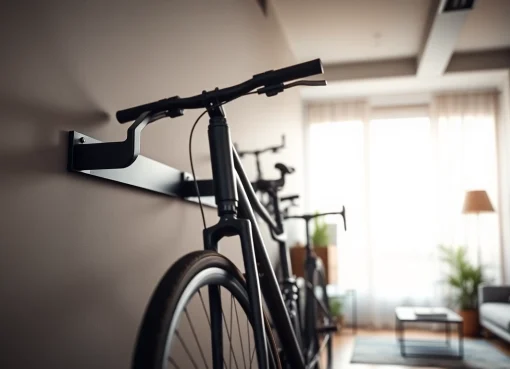A Comprehensive Guide to Choosing the Right Bicycle Wall Hanger

Understanding the Importance of a Bicycle Wall Hanger
The way we store our bicycles can have a significant impact on their longevity, our living spaces, and even the aesthetics of our homes. One increasingly popular solution is the Bicycle wall hanger, a practical tool that not only saves space but also offers protection for your bike. In this guide, we will explore the numerous benefits of using a bicycle wall hanger, types available, installation methods, and factors to consider when making your purchase.
Space Optimization Benefits
In urban environments where living space is often limited, maximizing available areas is crucial. Traditional bike storage options can consume valuable floor space in homes, garages, or sheds. A bicycle wall hanger effectively utilizes vertical space, freeing up room on the ground for other items. By mounting your bike on the wall, you can create an organized and clutter-free environment that is both functional and visually appealing.
Not only does this approach enhance the spatial dynamics of your home, but it also contributes to a tidy look. A wall-mounted bicycle can serve as a centerpiece or fit seamlessly into the background, depending on the décor, promoting a sense of order. You can even use bike storage as a part of your home’s design element, combining practicality with style.
Protection for Your Bicycle
Storing your bicycle improperly can lead to unnecessary wear and tear. Leaning a bike against a wall or allowing it to rest on the ground exposes it to potential falls, scratches, or damage from environmental factors like moisture and dirt. By using a bicycle wall hanger, you keep your bike elevated and away from the floor, reducing the risk of damage.
The proper wall-mounted system ensures that critical components, such as the frame and tires, remain secure and undamaged. This is particularly important for high-quality bicycles, where replacing components can be both time-consuming and costly. Moreover, wall hangers can provide stability while keeping the bike in a position that is less likely to attract dust and debris.
Enhancing Home Decor
A bicycle isn’t just transportation; it can also be a design statement. A trendy bicycle wall hanger can convert your bike into an eye-catching display item. With various styles available, from sleek, minimalist designs to more decorative options, you can choose a solution that complements your interior.
Imagine a beautifully designed bike hanging neatly on your wall, showcasing its unique colors and features, while also functionally saving space. This adds an element of customization to your home. Wall hangers can also enhance your personal brand as a cycling enthusiast, allowing you to share your passion for biking with your guests.
Types of Bicycle Wall Hanger
With the market offering a variety of bicycle wall hangers, it’s essential to recognize the differences in design, functionality, and application.
Horizontal vs. Vertical Options
Bicycle wall hangers can generally be categorized into two main styles: horizontal and vertical. Horizontal hangers hold the bike parallel to the wall, making it ideal for spaces with limited vertical clearance, such as garages or low ceilings. This design allows the bike to be reached easily without the need for extensive movements.
On the other hand, vertical hangers suspend the bike from the front wheel, usually requiring less horizontal space. This option can be more aesthetically pleasing in open areas, making it easier to display the bicycle as an art piece while effectively saving floor space. The choice between horizontal and vertical ultimately relies on your personal preference and the specific dimensions of your storage area.
Foldable and Adjustable Designs
For those who frequently change their bike storage needs or have limited wall space, foldable or adjustable wall hangers can provide great versatility. These designs allow the arms or supports to be tucked away when not in use. This provides a compact solution that can quickly adapt to various requirements, such as accommodating multiple bikes or maximizing available wall area.
Adjustable wall hangers that can fit different frame sizes are particularly useful for households with varying bike models. With this flexibility, you can customize storage to fit your immediate needs without investing in separate models, maximizing your investment utility.
Materials and Durability Factors
The material of a bicycle wall hanger is crucial to its durability and stability. Most commonly, hangers are made from steel, aluminum, or heavy-duty plastic, each presenting unique advantages.
– Steel is the most robust option, offering high weight capacity and resistance to wear. However, they may require more installation hardware and have higher price points.
– Aluminum provides a balance of lightness and strength but may not support as much weight as steel. It is often preferred for lightweight bicycles or environments where aesthetics take priority.
– Plastic wall hangers are generally the least expensive but may not support heavier bikes. They are ideal for occasional cyclists or less valuable models only needing minimal support.
Consider the durability of the materials when selecting your wall hanger, along with how long you plan to keep it in use. A well-constructed wall hanger can last many years with the right maintenance.
How to Install Your Bicycle Wall Hanger
Proper installation is crucial for the safety and effectiveness of your bicycle storage solution. Here’s how to do it effectively.
Required Tools and Materials
Before beginning installation, gather the necessary tools and materials:
– Drill with appropriate drill bits
– Level
– Stud finder
– Measuring tape
– Pencil for marking
– Screwdriver
– Wall anchors (if required)
– Safety goggles
– Bicycle wall hanger
Having everything in place ensures a smooth installation process and mitigates the risk of mistakes.
Step-by-Step Installation Guide
Follow these steps to securely install your bicycle wall hanger:
1. Identify the Location: Maintain enough space for your bike, and avoid areas with too much foot traffic or obstacles.
2. Find Wall Studs: Use a stud finder to locate wall studs, then mark their positions. Secure installation into the studs ensures stability.
3. Mark Hanger Placement: Measure and mark the ideal height for your hanger, making sure it’s a comfortable reach for you.
4. Drill Holes: If needed, drill holes for anchors if your wall material requires it; otherwise, drill directly into the stud.
5. Install the Hanger: Align the wall hanger with the drilled holes, then use screws to secure it in place.
6. Use a Level: Check the level to ensure that the hanger is straight, making adjustments as necessary before fully tightening the screws.
7. Hang the Bicycle: Finally, hang the bike on the wall mount and ensure it is stable.
Common Installation Mistakes to Avoid
Mistakes during installation can result in bike damage or unsafe setups. Common pitfalls include:
– Failing to locate studs can lead to a wall mount that isn’t securely supported, risking damage or collapse.
– Hanging the bike too high or too low can lead to inconvenience and difficulty whenever taking it down or putting it up.
– Using the wrong type of screws or screws that are too short can compromise the structural integrity of the hanger.
Measure twice, read the installation instructions carefully, and follow all safety protocols during installation to achieve the best results.
Choosing the Right Bicycle Wall Hanger for Your Needs
Selecting the appropriate wall hanger goes beyond aesthetics; various practical considerations will influence your final decision.
Factors to Consider Before Buying
Before purchasing, evaluate the following factors:
– Type of Bicycle: Consider your bike type (e.g., road bike, mountain bike). Different designs may support specific frame geometries better.
– Weight Capacity: Check the weight capacity of the wall hanger to ensure it can support your bike.
– Installation Requirements: Assess whether you want a permanent install or a removable option.
Each of these aspects will inform your options and ultimately lead you to a better purchasing decision.
Cost vs. Quality Considerations
When investing in a bicycle wall hanger, the relationship between cost and quality is significant. Generally, higher quality products with better materials and construction tend to have a higher price point. However, this does not always mean you need to buy the most expensive option.
A well-reviewed mid-range option may offer better value than a low-cost product that requires frequent replacement. Always consider long-term usability against initial costs, and look for reviews that detail user experiences over time.
Customer Reviews and Recommendations
Reading customer reviews can provide invaluable insights into the performance and durability of a product. Pay close attention to comments on:
– Quality and ease of installation
– Actual weight capacities versus advertised capabilities
– Effectiveness in keeping bikes secured and undamaged
Engagement with other cycling enthusiasts, whether online or face-to-face, can also guide your decision-making process. Look for recommendations that align with your particular use case and storage environment.
Maintenance Tips for Your Bicycle Wall Hanger
Keeping your wall hanger in optimal condition contributes to its longevity, allowing you to safely enjoy your bike for years to come.
Cleaning and Care Instructions
Regular maintenance is essential for ensuring the durability of your bicycle wall hanger. Dust and grime can accumulate over time, potentially leading to rust or decreased functionality. Here’s how to care for your hanger:
– Regular Dusting: Use a damp cloth to wipe down the hanger periodically, especially around joints and mechanisms.
– Anti-Rust Treatments: If constructed from metal, apply occasional anti-rust sprays or treatments, especially if exposed to moisture.
– Inspect for Damage: Routinely check for wear, cracks, or degradation in materials, ensuring it remains safe for your bike.
Regular Checks for Safety
Perform routine safety checks to maintain your wall hanger’s integrity:
– Tighten Connections: Ensure all screws and bolts remain tight, preventing loosening over time.
– Assess for Signs of Failure: Identify areas where the weight of the bike may be causing distortion or weakness.
– Replace Missing Parts: If screws or supports go missing, replace them immediately to avoid compromising safety.
When to Replace or Upgrade
As with any storage solution, there may come a time when replacing or upgrading your bicycle wall hanger is necessary:
– Material Degradation: If you notice rust, corrosion, or permanent bending in metal parts, it’s time for a replacement.
– Increased Weight: If you purchase a new, heavier bike, consider an upgrade to a model that can accommodate the added weight.
– Design Changes: Personal aesthetic preferences may prompt a change to better match your current décor.
Staying mindful of these considerations can ensure that your wall hanger remains a reliable, safe storage solution for your bicycle.



Leave a Comment